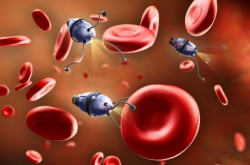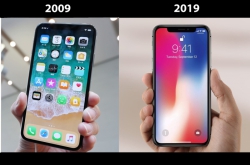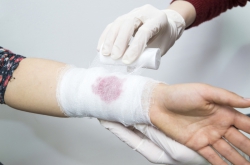VR for mental illness treatments
The most obvious application of VR in the field of medicine is therapy for post-traumatic stress disorder (PTSD). The main reason of PTSD is a negative experience which can be caused by war or some other kind of violence. Patients with PTSD feel anxiety and have troubles with communication. Sometimes, it leads to losses of memories connected with the negative experience. One of the treatments is to remind patients about the traumatic situation. VR-based treatment can be combined with talk therapy. The method may seem cruel, but in fact, it teaches how to control oneself and avoid panic attacks.
Source: ScientificAmerican.
VR for diagnostics
One other application of VR is early diagnosis of neurodegenerative diseases. For this purpose scientists from Tomsk Polytechnic University and Siberian State Medical University work on a diagnosis system based on VR technology. The system includes a series of functional tests. Special sensors analyze how people can adjust to changing conditions. Healthy people can do them easily without losing balance, while those with disorders lose orientation in space. According to the statistics, Parkinson's disease can appear at age of 30, but the patient doesn’t feel the first symptoms until 50. The new test system can help diagnose various neurodegenerative diseases in early stages.
Source: Science Daily

Photo credit: virtualreality24.ru
VR for surgery
Specialists from the Institute of Cardiology, Warsaw, successfully removed a blood clot from the occluded coronary artery using a wearable VR device based on Google Glass, with an optical head-mounted display. The device was used to provide computed tomography angiography for analyzing blood vessels. The system allowed surgeons to enlarge images so as to look at the process in great detail.
Read more: First-in-Man Use of Virtual Reality Imaging in Cardiac Cath Lab to Treat Blocked Coronary Artery
VR for struggling with pain
VR can distract patients' attention from pain, believe researchers from the Royal Society. They involved in the experiment over 25 volunteers and asked them to hold their hands in cold water for as long as possible. Those who played VR games during that could bear the pain longer than others.
VR technology can even be used to make the process of childbirth easier, if a woman reads recommendations on how to breathe and what to do using VR glasses. Also, the technology can help distract children’s attention from painful medical procedures.

Virtual and augmented reality is able to treat phantom pains. Researchers from Chalmers University of Technology developed a system for treating phantom limb pain. Special sensors fixed on muscles near the amputated limb receive signals that the brain gives to the limb. Then, the patient looks at the monitor, which shows how a virtual limb executes the command. This activates brain parts responsible for managing the amputated limb. The method reduces phantom pains more effectively than other treatments.
VR for exoskeletons
European scientists plan to apply VR to a new robotic exoskeleton, which can be managed by brain signals. Paralyzed patients will get an opportunity to control the skeleton using electroencephalogram which converts brain signals. However, it needs special preparation — patients will use VR to train consentration abilities.
VR to bluff your brain
One can also find the information that VR helps create placebos. The well-known effect works like this: one takes a fake pill and feels better. Sometimes, this method is effective, even if the patient knows that he takes, for instance, sugar, instead of a medication.

Photo credit: dentalgeek.ru
According to some theories, it may help because of acquired reflexes. Just remember an experiment with Pavlov’s dogs. Every time when dogs were given food they heard a ring of bell. When they’d learnt this behavior, they started salivating at the sound, even if the food was not given. Placebo works in the same way — we know that pain relievers reduce pain, and cause endorphin release. That is why even if we take a fake pill, we aim to bluff our organisms into producing endorphin themselves.
For example, using VR and AR, one can show a patient how leucocytes kill bacteria in his or her body or demonstrate how he lives after fighting off his disease. These days, scientists don’t know for sure how these physiological mechanisms work, but it is obvious that the mental condition of a patient plays an important role in the recovery process.




